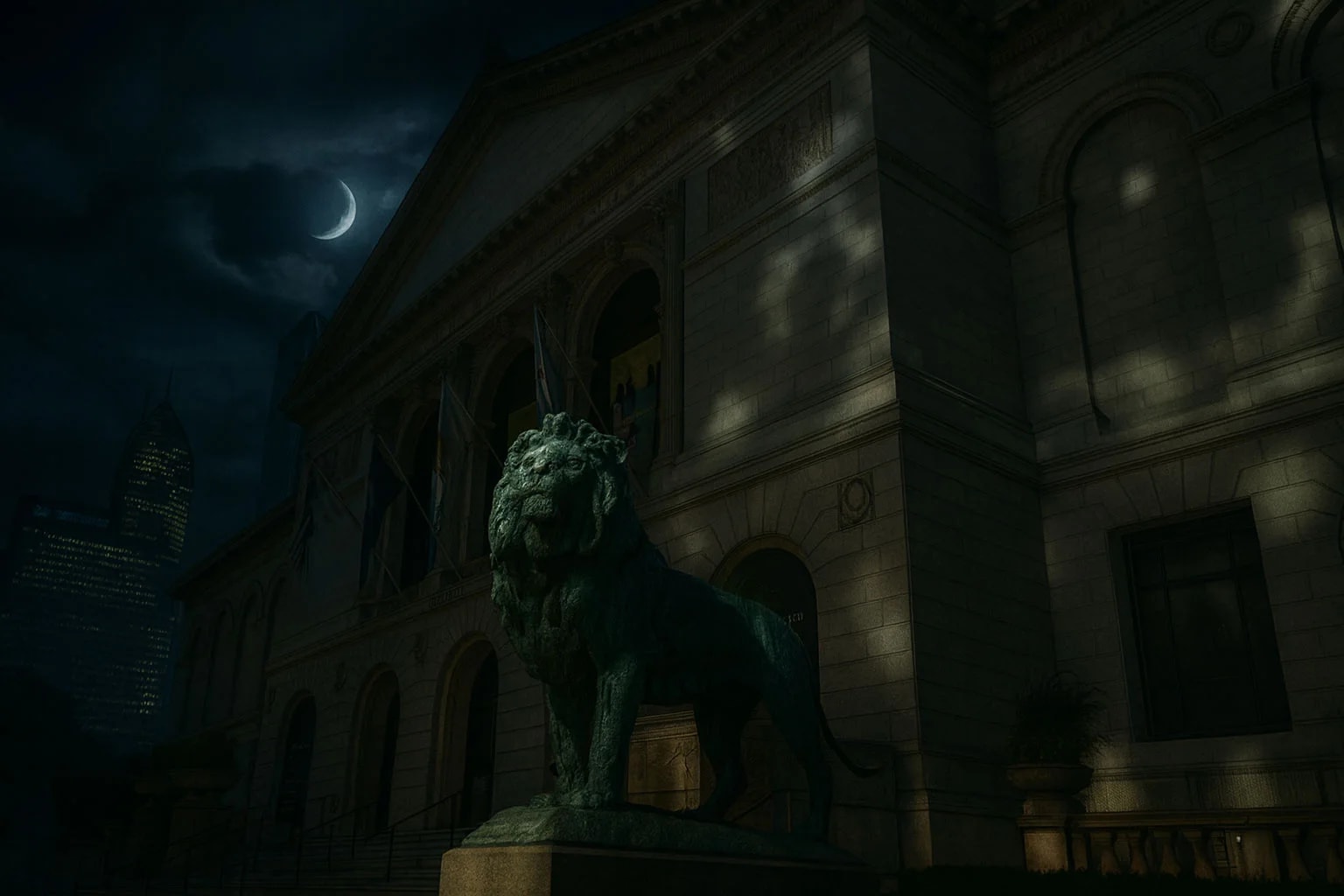Flanked by two massive bronze lions that have become symbols of Chicago itself, the Art Institute stands as a temple to human creativity. Within its Beaux-Arts building on Michigan Avenue, millions of visitors each year encounter works by Monet, Picasso, Grant Wood, and countless other masters.
The museum's collection spans five millennia and six continents, from ancient artifacts to contemporary installations. Its galleries are quiet spaces of contemplation, where visitors stand in reverence before some of humanity's greatest achievements.
But the Art Institute harbors secrets beyond its famous collections. Security personnel working the graveyard shift report footsteps echoing through empty galleries. Motion sensors trigger without visible cause. And some visitors claim to have encountered figures that seem from another era, dressed in fashions decades out of date, gazing at paintings with an intensity that transcends time.
In a building devoted to preserving beauty for eternity, it seems that some souls have chosen to remain, continuing their appreciation of art long after their mortal lives ended.
The History of the Art Institute of Chicago
The Art Institute of Chicago was founded in 1879 as both a museum and school, with a mission to bring art education and appreciation to the growing city. The institution began in rented quarters before moving to its current location in 1893.
A Palace for the People
The Art Institute's iconic building was constructed for the 1893 World's Columbian Exposition, where it served as the World's Congress Auxiliary Building. Designed by the Boston architectural firm Shepley, Rutan and Coolidge in the Beaux-Arts style, the structure was intended from the beginning to become a permanent home for the museum.
The building's grand facade, with its arched entrances and classical detailing, proclaimed that Chicago - still recovering from the Great Fire of 1871 - had arrived as a world-class city. The two bronze lions, sculpted by Edward Kemeys, were added in 1894 and quickly became beloved symbols of both the museum and the city.
From its earliest days, the Art Institute's mission was democratic - to make great art accessible to all people, regardless of their background or education. This philosophy attracted not just the wealthy elite, but working people, immigrants, and students eager to encounter beauty and culture.
Building a World-Class Collection
Through generous donations, strategic acquisitions, and far-sighted curators, the Art Institute assembled one of the world's premier art collections. The museum became particularly renowned for its Impressionist and Post-Impressionist paintings, including Georges Seurat's "A Sunday Afternoon on the Island of La Grande Jatte" and Grant Wood's iconic "American Gothic."
Over the decades, the building expanded multiple times to accommodate its growing collection. Major additions in 1916, 1977, and 2009 have created a complex of galleries and exhibition spaces that can take days to fully explore.
Throughout its history, countless individuals have devoted their lives to the Art Institute - curators who spent decades studying and caring for the collection, guards who protected the artworks through wars and social upheaval, and donors whose passion for art drove them to support the museum. Some, it seems, loved the institution so deeply that they never truly left.
Tragedies and Mysteries
Like any institution of its age and size, the Art Institute has witnessed its share of human drama. Staff members have died on the premises over the decades - from heart attacks and strokes to at least one tragic suicide. Valuable artworks have been stolen, damaged, and recovered under mysterious circumstances.
During World War I and World War II, the building took on additional significance as young men preparing to ship overseas made final visits to see beauty before potentially facing death. Some never returned. Others came back forever changed, finding solace in the quiet galleries.
These layers of human experience - devotion, tragedy, passion, and loss - have created what paranormal researchers call a "spiritually active" location, a place where intense emotions and significant events have left an imprint on the building itself.
The Ghosts of the Art Institute
The paranormal activity at the Art Institute is typically subtle and refined - much like the museum itself. Rather than violent or frightening encounters, witnesses report experiences that suggest the presence of art lovers who simply haven't left.
The Devoted Curator
Security guards working overnight shifts have reported encountering an elderly gentleman in old-fashioned clothing - typically described as wearing a suit from the 1940s or 1950s - walking slowly through the galleries, his hands clasped behind his back, studying the paintings with intense concentration.
When approached, he seems not to hear or acknowledge the guard's presence. If directly confronted, he simply fades away, sometimes mid-step. He appears most frequently in the Impressionist galleries and in the rooms housing European paintings from the 17th and 18th centuries.
Long-time staff members believe this is the ghost of a former curator who devoted his life to the museum's collection. According to museum lore, he spent so many hours studying the paintings that he could identify any work in the collection by the smallest detail. In death, he apparently continues his rounds, eternally appreciating the masterpieces he helped protect and interpret.
Some security personnel report that his appearance often precedes the discovery of a problem with a painting - moisture issues, subtle damage, or environmental concerns. They've come to see him as a benevolent presence, a ghostly guardian still protecting the collection he loved.
The Woman in the Modern Wing
In the museum's Modern Wing, added in 2009, staff and visitors have reported seeing a young woman in 1920s clothing - a dropped-waist dress, cloche hat, and period shoes - standing before the contemporary art installations with an expression of wonder and confusion.
Witnesses describe her as appearing completely solid and real, not transparent or obviously ghostly. She seems transfixed by the modern artworks, particularly the abstract pieces and installations that would have been revolutionary in her era.
When visitors try to speak with her or ask if she needs help, she turns toward them with a startled expression and vanishes. In some accounts, she doesn't disappear entirely but seems to walk quickly away, only to be gone when witnesses follow.
Paranormal researchers speculate that she might be a time-slip phenomenon - a glimpse of someone from the past somehow intersecting with the present. Others believe she's the spirit of an art student or young artist from the 1920s who died tragically and continues to explore the evolution of art she never got to witness in life.
Footsteps in Empty Galleries
Perhaps the most commonly reported phenomenon at the Art Institute is the sound of footsteps echoing through galleries that security has confirmed are empty. These aren't random creaks or settling sounds - witnesses describe the clear, purposeful stride of someone walking through the museum.
The footsteps often follow predictable patterns, as if someone is taking a regular route through favorite galleries. Security personnel have tracked the sounds, watching on camera as the footsteps' trajectory is revealed by pressure-sensitive floor alarms triggering in sequence - yet the cameras show no visible person.
Sometimes the footsteps are accompanied by other sounds:
- Pages turning, as if someone is consulting a guidebook or catalog
- Soft sighs or exclamations of appreciation
- The rustle of clothing moving
- Whispered conversations between two or more invisible visitors
These phantom visitors seem most active in the hours just after closing, as if they're waiting for the living crowds to depart before beginning their own eternal tour.
The Guardian of the Artifacts
In the galleries housing ancient artifacts - particularly the Asian and Egyptian collections - security personnel have reported encounters with a presence that feels protective rather than passive.
Guards describe a sensation of being watched while making their rounds through these galleries, particularly near the most valuable or sacred artifacts. Some report a feeling of being gently prevented from approaching certain pieces, as if an invisible guardian is blocking their path.
When art handlers work late preparing exhibitions or moving pieces in storage, they've reported tools going missing and reappearing in odd locations, and careful arrangements being subtly altered overnight. While frustrating, these phenomena have occasionally prevented damage - a cart blocked from rolling too close to a fragile piece, or a ladder mysteriously moved away from a structurally questionable wall.
Curators familiar with the phenomenon believe this protective presence might be connected to a long-deceased museum guard or conservator who took their duty to protect the collection so seriously that they continue to stand watch even after death.
Cold Spots and Electromagnetic Anomalies
Museum staff have identified specific locations within the Art Institute where unexplained temperature drops occur. These cold spots aren't related to HVAC issues or drafts - they appear suddenly in the center of galleries, often in front of particular paintings.
The affected artworks vary, but some pieces seem to generate cold spots more frequently:
- Paintings depicting tragic or melancholic scenes
- Portraits of individuals who died young or under tragic circumstances
- Works created by artists who suffered mental illness or died by suicide
- Religious or spiritual artworks from various cultures
Paranormal investigators who've been granted after-hours access have documented significant electromagnetic field fluctuations in these areas. EMF meters spike without visible cause, and digital equipment often malfunctions - cameras drain batteries, recorders capture static or strange sounds, and phones freeze or restart.
Some researchers theorize that certain artworks, particularly those created during periods of intense emotion or spiritual devotion, might somehow retain or attract spiritual energy.
The Docent Who Never Left
Several visitors have reported receiving guided tours or detailed information about artworks from a kind, elderly woman who seems to be a museum docent. She's described as passionate and knowledgeable, offering insights that enhance their appreciation of the art.
The strange part? When these visitors later try to thank her or find her to ask additional questions, museum staff have no record of anyone matching her description working that day - or in some cases, anyone matching her description having worked at the museum in recent decades.
In a few documented cases, the information she provided has proven to be accurate but obscure - details about an artist's technique or the history of a particular piece that would require years of specialized study to know. When visitors ask staff to verify these details, curators are surprised to confirm the accuracy of the mysterious docent's information.
Long-time museum employees believe this might be the spirit of a former docent or educator who loved sharing art with others so much that she continues offering tours even after death, unable to let go of the joy she found in opening others' eyes to beauty.
Experiencing the Art Institute Today
The Art Institute of Chicago remains one of the world's great museums, welcoming over 1.5 million visitors annually to its magnificent collection. The museum is open to the public most days of the year, offering both permanent collection galleries and special exhibitions.
While you explore the masterpieces, pay attention to your surroundings. That well-dressed figure studying a painting with unusual intensity might be from another era. Those footsteps echoing from an adjacent gallery might belong to a visitor you can't see. And if you encounter an extraordinarily knowledgeable docent who vanishes before you can properly thank them, you might have experienced the Art Institute's most devoted guide.
The museum stands at 111 South Michigan Avenue, between the bronze lions that have guarded its entrance - and perhaps its eternal visitors - for over a century.

The bronze lions guard more than just the entrance

Where phantom visitors still admire the masterpieces

